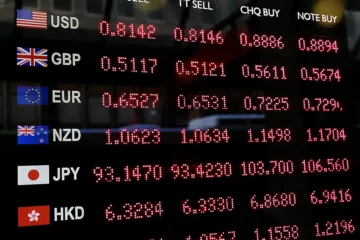“May you live in interesting times” says a Chinese proverb… Well, 2018 was actually pretty interesting to say the least for markets, with 93% of asset classes posting a negative return in USD terms – this figure is astonishing not only when compared to last year when only 1% of assets recorded negative US$ returns but also when looking back in history: researchers at Deutsche Bank show that this over-ninety per cent figure is unmatched in the last 100 years (basically, since the beginning of modern finance). As a further comparison, asset classes with negative return in $ terms in the years of the Great Financial Crisis were only marginally above 60%… And, what is even more incredible, are those assets that delivered a positive return. In Europe, the most important asset posting positive return is, drumroll, Bund! Who would have thought it? In fact, the bond markets with the lowest yields at the start of the year are among the best performers today.
All other €-denominated fixed income securities instead have gone through a quite disappointing year with high yield bonds suffering the most together with financials that, in addition to other common factors, suffered because of the repricing of the first rate hike from September-December 2019 to March 2020, as shown by Eonia forwards, which is perceived to weight on financials’ net income. As mentioned before, the “ECB hike” is thought not to happen before 2020, implying that President Draghi will finish his 7-year tenure at ECB without rising rates. But whether a rate hike will eventually happen in 2019 or 2020, it is quite unlikely that it would be a true rate hike – in fact, European Central Bank board may simply opt for narrowing the corridor by 10 basis points as the current 40 basis point spread between the deposit rate and the main refinancing rate does not seem to be what the ECB will like to see in its long-term future – narrowing the corridor before rising the main refinancing rate (currently at 0.00%) thus seems the most likely option for the first rate hike since 2011.
In addition to the “mere return”, 2018 has been quite remarkable for volatility shocks. In fact, the highest number of outsized volatility shocks (defined as higher-than-3 standard deviations movements) since 2008 were recorded. And these sharp movements all happened while monetary conditions are still on the “expansionary side” even in the United States (in spite of the four hikes of the Fed).
This cosmic pessimism in markets does not seem to be justified when one looks at macro data. Sure, growth consensus forecast indeed points to a slowdown of regional and global growth – but these figures are far from signalling a recession (i.e. negative GDP growth). In fact, consensus real GDP growth for emerging market points at 4.9% whilst a more modest 2.1% is forecasted for developed markets, with Euro Area growth consensus at 1.7%. Overall, the global GDP growth is forecasted at 3.6% both for 2019 and 2020.
In addition to this, each pre-recession cycle period does show some common features: the ISM Manufacturing index for the US below 50, a negative Industrial Production growth, an increase in the Initial Jobless Claims higher than 60’000 units and a year-on-year retail sales growth lower than 2.5%. None of these has been recorded as of today. However, it should be noticed that a tightening of credit conditions (measured by indexes such as the Goldman Sachs Financial Condition Index) has indeed taken place.
However, one should not forget to look at the US rates curve as, in the past, an inverted US yield curve has proven to be among the best pre-crisis indicators for the last seven recessions. And indeed, the curve is almost flat and has been marginally negative for some buckets, such as the 3y-5y segment, during 2018. Whilst an inversion of the term structure of US rates does not look like a positive thing, one should keep in mind that the last time this happened (August 2005) recession was 28 months away – however the curve bucket that should be more considered is the 2-10, whose spread is currently still positive, as this sector actually inverted for the past nine recessions. Also, it is fair to assume that special caution should be adopted when looking at the inversion of yield curve as the effect of unconventional monetary policies may still compress the term premium on longer US Treasury maturities, given the huge amount of United States’ federal debt securities held by the Fed, which may have flattered the yield curve. In other words, whilst “one of the most pervasive relationships in macroeconomics is the one between LT and ST interest rates – and future economic activity” one should keep in mind that the effectiveness of an inverted yield curve as a recession signal has never been tested since central banks expanded their national debt holdings as a result of quantitative easing policies. On top of that, there are sectors of the US curve that actually steepened in the last 6 such as the 5-30 years bucket. [1]
In fact, models have quantified the “QE premium” for German Bunds to be roughly equal to 100bps and this premium seems to be more related to the stock rather than the flow of debt securities held by central banks – if this is truly the case, it is fair to assume that low term premium and elevated “unconventional monetary policies” premium are not going to fade away anytime soon and simply because of the end of net asset purchases (as a reminder, the ECB has stopped its net purchases in December 2018). In addition to this German Bunds also benefit from their scarcity, given marginally negative net issuance and sound German fiscal policies, and their role as €-denominated safe-heaven asset.
As European Government Bond supply has been mentioned, it is worth noting that, because of the end of net asset purchases by the European Central Bank, the net supply of government bonds that the market will need to digest will increase substantially from €64 to €233 bln, even if the gross supply remains roughly unchanged around € 860bln. European elections in May, whilst unlikely disruptive (polls show that the majority of the European Parliament seats will likely be won by “pro-€uro(pe)” parties) may increase volatility on European rates, also given populists party now ruling key countries such as Italy and the falling approval rate for Macron (seen as the best hope for Europe until a couple of months ago). Therefore, with the ECB out of the game, the pursuit of the marginal buyer for BTPs will be at the centre of 2019, even if supply from the Belpaese will be manageable.
Politics is definitely having a huge impact on some €-denominated government bonds, especially on the Italian ones: in fact, 100 bps of the current 10y spread vs. Germany are actually due to redenomination risk premium, as shown by the CDS spread (the difference in premia between the CDS under 2014 legislation and the one under 2003 legislation. As the former one does not register a redenomination as a default event, the spread between the two premia is a proxy for the redenomination risk priced in BTPs). Clearly, this “Ital€xit” premium makes Italy cheap versus the fundamentals of the country. However, as the risk of future downgrades from investment grade to high yield is substantially higher than zero, the Italian relative cheapness seems justified, because the transition to the high yield universe would carry disastrous consequences, namely the investor base rotation, as a non-negligible share of BTPs buyers would not be allow to buy them anymore or would be force to reduce their purchases, and regulatory constraints (most importantly, BTPs would lose their status of ECB-eligible collateral).
Overall, the year that has just begun is set to be definitely not easy for markets. However, the growth consensus figures point to a solid growth both in 2019 and 2020 (even if at a considerably slower pace than last year) and typical signs of recessions are not showing up as of today.
Having all the above-mentioned things in mind, next year Italy is definitely to watch out as, on top of the crazy budget law approved that sets VAT increase for about € 51 bln in 2020, there are considerable rumours of already negative GDP growth in Q4 (after all, economic agents may move on expectations as theory tell us) as well as volatility on European rates in the journey to and through the European Elections.
Another topic worth of attention is the noisy silence of core inflation, particularly in Japan and in Europe, where, despite of the absorption of slack in most euro-area countries and the acute shortage of skilled labour in Germany, there are few signs of a pickup in underlying inflation.
On top of that, we would like to highlight how liquidity has been evaporating in the last years, partly as a result of new regulations and unconventional monetary policies. One figure may explain better than words: the free float in German Bund is only marginally higher than 20% whilst it was more than 50% ten years ago.
On a different note, due to a short-term interest rate reform, Eonia and Euribor are set to lose their status by the end of the year, with gaps to the new or revised reference rates expected to be less than 10bp.
Finally, it may be interesting to see how liquid ETFs with a not-so-liquid underlying will perform, should credit markets enter a severe bear market. In fact, most of non-synthetic credit ETFs do track the reference index by using a fraction of corporate bonds actually included into the underlying and this can pose challenges when a large number of small default happen (think for instance in the High Yield space) and also in the event of a downgrade (pre-recession period are usually the one in which the highest number of corporate downgrade happens, particularly from IG to HY) that may put some “theoretically liquid” ETFs in a position of forced seller of a “not so liquid” underlying.
[1] Quote from “Economic forecasts with the yield curve”, FRBSF Economic Letter – March 2018.



0 Comments